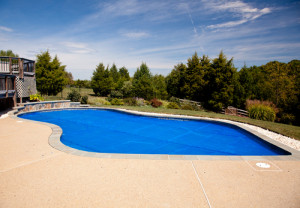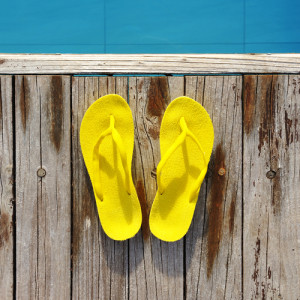Enjoying your new home with the pool in the backyard, but concerned about keeping it green?
What steps can a homeowner take to keep that pool as eco-friendly and energy efficient as possible?
Here are 10 great options to green your pool:
1) Energy efficient pump. Replace an older model pump, which may have been less efficient, and larger than it needed to be, with a smaller pump that will be more energy efficient. If you choose a variable speed pump, you can better control how quickly the water gets circulated, using less energy in the process.
For more information about the range of energy efficient options for a pool, go here and here.
2) A windbreak. One of the biggest sources of water loss for a pool is through evaporation. In addition to the water that is lost is the energy used to heat and circulate that water through the pool. A windbreak—added to the fence around the pool—reduces that water loss by cutting down on the evaporation.
3) Solar pool cover. When the pool sits idle and exposed, evaporation occurs, even with a windbreak. A solar pool cover, which lays on top of the water, will greatly reduce that evaporation, and help warm the water as well. Choices range from a simple cover that deploys like a giant sheet of bubble wrap, to sophisticated models which unfold at the push of a button.
4) Pump timer. The water in a home swimming pool can generally be circulated properly by running the pump only a portion of the day. A timer on that pump system allows the pool owner to run the pump only the amount of time needed to circulate the water, and then the pump shuts down, saving energy.
5) Solar heating. An alternative to traditional pool heaters is to install an eco-friendly solar heater. By capturing and concentrating the energy of the sun, these heaters allow the pool to stay warm enough for the family to be comfortable, but without gas or fuel being used.
6) Ultraviolet pool cleaners. These cleaners use ultraviolet light to remove contaminating particles as the water flows through them. Though they don’t completely eliminate the need for some chlorine use, they are much more eco-friendly because they use so much less of the traditional pool chemicals. While chlorine is the most common form of pool cleaner, because it has potential toxicity issues, it is a source of health risks for humans.
7) LED Pool lights. LED bulbs use a sophisticated technology to more efficiently light the pool. They last for up to 40,000 hours, whereas an incandescent bulb lasts about 5,000 hours. The LED bulbs create light without the high heat extremes of the more traditional options, using less energy to operate.
 8) A heat pump. These pumps are an eco-friendly option that draw thermal energy from the surrounding air to heat the water in the pool. They don’t actually generate heat—they just transfer it. These pumps are typically best in climates with a moderate need for heating, and warm weather outside.
8) A heat pump. These pumps are an eco-friendly option that draw thermal energy from the surrounding air to heat the water in the pool. They don’t actually generate heat—they just transfer it. These pumps are typically best in climates with a moderate need for heating, and warm weather outside.
9) Robotic pool cleaner. It is easy to postpone pool maintenance, only to discover buildups of algae or stains, that require a lot more effort to clean up. For the busy pool owner who might forget, a robotic pool cleaner will make maintenance a lot more steady, thus reducing the need for things like a chlorine blast to address problems that have developed.
10) Salt water pools. This option uses a chlorine generator to naturally create chlorine, thus greatly reducing the amount of regular chlorine needed for the pool. While it doesn’t eliminate the need for the use of traditional chlorine for sanitizing purposes, the amount used is much less, making a salt water pool a very eco-friendly choice.
Bonus:
Listen to this Green Divas At Home podcast segment featuring Supernatural Mom talking about items in your home that could be aging you prematurely!
Cathy G.
July 23, 2014 at 8:49 am
wonderful article. I just got a variable speed pump and it is working out wonderfully. I have actually written a little article about it because my son convinced me to take my passion for green living and be proactive and try my hand at writing. I’ve never been much of a writer but here is my story about how I got my variable speed pool pump!
I didn’t need any convincing to join the green movement. My contributions started out small: I ditched the plastic water bottle for a reusable water bottle, made the transition from standard light bulbs to high-efficiency, LED light bulbs, and tried to take my bike instead of my car whenever I could. While small, these changes yielded results! Not only did my monthly utility bills go down, but the increase in exercise made me feel great! So, I began considering other ways I could reduce my carbon footprint. I said goodbye to harsh chemicals and hello to eco-friendly cleaning products, started buying in bulk and taking shorter showers. But one of biggest switches I made (and also one of the easiest) was right in my backyard. Who knew?
It’s no secret, we Floridians love our pools. There are 14 on my street alone! So, at the start of pool season, I couldn’t help but notice swimming pool service trucks pulling up to my neighbor. When I inquired about it, she told me that she was exchanging her single speed pump for an energy-efficient, cost-effective variable speed pump.
A variable speed pump? What’s that?
I have a friend in California who is basically taught me everything I know about going green. When I gave him a call to see what he knew about this he said that he had just recently had one installed. A variable speed pump, when properly programmed, can be between 40% and 80% more efficient than a single speed pump. The difference in percentage is due to different pumps but more so because of the way it is installed by the technician.
So, I talked to him, did some research and talked to a couple of pool technicians. Apparently, unlike a single speed pump, which will run continuously, a variable speed pump will only work as hard as it needs to. Every pool is different and therefore has different needs. The average homeowner saves up to 60 to 70% on their monthly utility bill after making the switch from a traditional speed pump to a variable speed pump. Plus, a variable speed pump has a near-silent operation and a long service life. At this point, the prospect of getting one seems like a really good idea.
First however, I had an eco-friendly pool technician come to my home and performed a free home energy survey of my pool system, and with my electricity bill, he calculated what my pool system was costing me and what I would save with a high efficiency filtration. It was around.
The change I made may seem like a small “splash” in the grand scheme of things. But, multiply that small splash by 14 (that’s right most of the people on my street have got one or are getting one) and that small splash quickly becomes a small wave! Who would have thought that something as simple as a pool pump could make such a big difference?
Two things I highly recommend when you get a variable speed pool pump. 1) Get a reputable technician that is familiar with the technology because the pump itself will save you around 40% but it is the technical set up that will make it up to 80% or so. 2) Make sure they perform a free energy survey so you know how efficient the system should be and that they can give some form of a guarantee.
I got the work done by a person I met through my neighbor, who was a friend of theirs so I got the work done at a low rate. My friend in California got it done by Eco-Solar. That company services only northern Cali but they have a good website for both basic and technical information. http://WWW.ECOSOLARPOOLS.NET
Other sites I would recommend for research purposes are: http://www.pentairpool.com/products/pumps-inground-intelliflo-variable-speed-pump-430.htm this is the company for my variable speed pump. But I’m sure there are many other quality brands out there.
Thanks green divas!
Pingback: 7 Tips for a Relaxing Staycation | Care2 Healthy Living